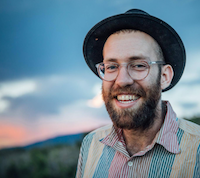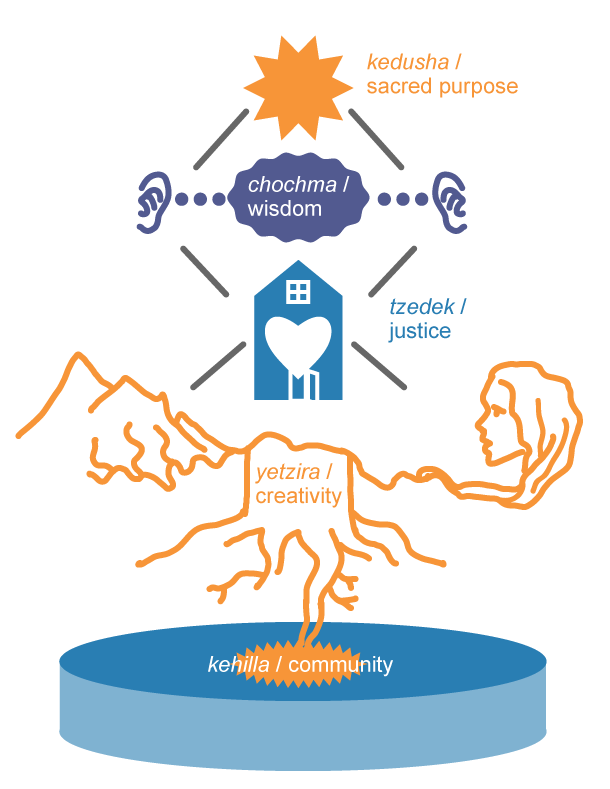Jewish Liberation that Spans Generations
The megatrends Rabbi Sid invokes in his article are mega not in their 
The seed of Taproot was a dream of intergenerational Jewish wisdom transmission. Young bridgebuilders who had been cultural arts organizers, who longed to be immersed in their own culture, young organizers in the movement for black lives were asked by their black friends to more deeply interrogate their Jewish identity. Young interfaith organizers, awash in vague generalities, wanted to tap into the ancient root stock of Judaism in order to have something of meaning to share in diverse spaces. We found many young Jews longing for the ancient and mystical teachings to be accessible, relevant, real, and centered in their own lives.
And just as the calf needs milk, the cow needs to give it. Older rabbis, who had created vast bodies of work in embodied prayer and taught mostly elders, started to look at their legacy. They longed for more intimate connection with the next generation. Congregational rabbis longed to be in touch with the radical edges of Judaism. Emerging rabbis longed for a place to teach where they didn’t have to do all the prep and gather all the people but could also be fed by the experience of being together. With so much hunger for intergenerational connection it’s a miracle we didn’t devour each other.
The special sauce of Taproot, why this community works, is that from the very beginning it was the result of rabbis and the younger generation in creative cahoots. One is not designing the experience for the other, but with the others’ perspectives and needs. The generational gap is wide. I have been involved with plenty of projects where the younger generation asks: “Where are the elders?” and some other projects where the elders ask: “Where are the young people?” We will continue to mystify each other unless we are willing to accompany each other, from the beginning, through the design, to be good company through the unknown.
The commitment of the stewards of this kehilla to each other, generates an unmistakable family feel. Young people in my community have lost all patience for sage on the stage teaching and question anyone whose spiritual power rests in a title rather than a way of being in the world. We’re grateful to be working with three rabbis–Rabbi Diane Elliot, Reb Irwin Keller, and Rabbi Eli Herb–who are humble and chutzpahdik, and offer many modalities for Jewish learning, through the text, through the earth and through the body. From the fringes of Jewish identity–being queer, a convert, and a woman–they have alchemized a vibrant and deeply relevant way of inhabiting Judaism. They work with four younger stewards–Adam Horowitz, Rachel Platus, Devra Goldstein and me–who are also experienced facilitators and who help to convene the gatherings. The result is a mix of collaborative teaching and emergent learning facilitation.
This bridge building between generations is of little benefit unless we are also reaching out beyond ourselves to work in the world. The healing of Jewish people is important and can’t happen without black liberation. The fight for freedom and dignity for Palestinian people is also bound up in the fight for the soul of the Jewish people. Our Judaism is not relevant unless the benefits of it extend beyond ourselves and inform how we show up for our work in the world.
At Taproot we put prayer and justice work in dialogue. We look at what prayer practices embolden resilient action in a time of climate catastrophe. We imagine ceremonial action that we can take together. We understand the necessity of doing our work prayerfully. Taproot is not about creating movement leaders. Everyone that comes to Taproot is already engaged in the healing of our world (teaching, social work, immigration justice, solidarity economy, arts activism, unlearning whiteness, queer/trans rights). Taproot is also not about instrumentalizing Judaism, valuing it only in its use and application to justice work in the world. We are building resources, connection and everyday practices for people to show up as human, in covenantal kehilla, to play their sacred role in this blessed and broken world.
______________
David Bronstein is a grassroots educator passionate about making liberatory spiritual education accessible. He is an organizer of Taproot, and helped start Alt*Div, an alternative to divinity school.


